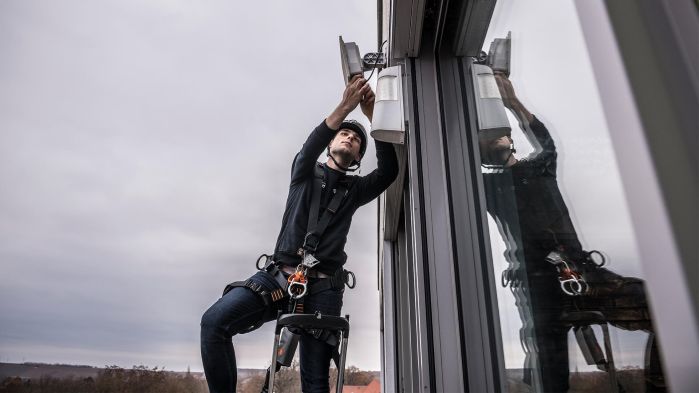In logistics halls, more and more end devices that require a stable WLAN connection are being used. In exhibition halls, universities or schools, it is a large number of visitors, students and pupils who connect to the WLAN via their smartphones, tablets or laptops. In the home, on the other hand, there are more and more smart devices that communicate via the internet. And that can lead to an overload of the network.
With the new Wifi 6, users with corresponding clients can communicate at higher speeds and more end devices can use a router in parallel. When Wifi 5 was introduced, the average household had only a few devices that used a wireless internet connection. Today, especially in the age of the Internet of Things (IoT), the number of Wifi-capable devices is increasing rapidly. Until now, access from many devices at the same time led to an overload of the WLAN router. With the new WLAN standard, data is bundled and distributed more efficiently. This ensures a smoother and more stable connection.
Reduced latency per client
The previous standards showed their weaknesses especially in "high-density environments" where many end devices use the WLAN. These transmit simultaneously and the high number of data sent collides. With Wifi 6, this can be reduced because the standard can deal more efficiently with the scarce, available channels and bands or distribute them better. This provides more stability and reliability in high-density environments. The lower latency per end device is a clear advantage over previous standards.
High throughput due to many IoT devices
The number of Internet of Things devices is steadily increasing and Wifi 6 is also showing its strength here. Especially in environments with very many IoT devices, for example in smart cities, the available bandwidths must now be managed and allocated even more efficiently. This means that high throughput and low latency are a priority. This is because the data generated by the sensors of these devices must be forwarded quickly without disrupting or delaying bandwidth-hungry applications such as 4K video streaming.
To benefit from all the advantages of the new WLAN standard, both the access points and the end devices must be Wi-Fi 6 certified. Many manufacturers advertise Wi-Fi 6 compatible end devices, but they cannot use all the features, such as OFDMA uplink. It is therefore advisable to look carefully at the data sheet when selecting new devices. As with all other WLAN generations before it, the standard is backwards compatible. This means that older clients can transmit and receive in a Wi-Fi 6 infrastructure without any problems, but cannot use all the new functions.
New and familiar features, now working even more closely together, ensure progress from Wifi 5 to Wifi 6:
- Multi-User Multiple-Input, Multiple-Output (MU-MIMO)
Through MU-MIMO, the different data streams are now transmitted simultaneously in upload and download and to multiple clients. This significantly reduces waiting times in the radio field. MU-MIMO is particularly efficient with high client density and bandwidth-hungry applications, because it also brings improvements in latency and throughput.
- Smart Standby Mode: Target Wake Time (TWT)
Intelligent "wake-up mechanisms" significantly extend the battery life of WiFi 6 clients by switching them to standby mode as soon as they are no longer transmitting via WLAN. This is enormously important, especially for mobile end devices and battery-powered IoT devices.
- Increased information density with QAM-1024
Due to a higher information density with Wifi 6, the data throughput is significantly increased with QAM-1024.
- Optimising the Wi-Fi 6 frequency range with subcarriers
Often a WLAN client sends only very small amounts of data within a time window. OFDMA (Orthogonal Frequency Division Multiple Access) optimises the complete frequency range of a WLAN channel in one time unit by forming several subcarriers. This gives several devices the opportunity to transmit and receive at the same time. Several devices thus effectively fill a timeslot of a channel.
- More transparent communication via Basic Service Set (BSS) Coloring
If neighbouring access points use the same channel, they interfere with each other. With the previous WLAN standards, only one could transmit and the other WLAN clients on the channel had to wait. Even with sufficient spatial distance, this was the case. The new WLAN standard gives the devices the possibility to communicate with each other more transparently. Individual SSIDs are "colour-coded". The Wi-Fi 6 clients recognise and distinguish devices based on the "colours" on the same channel. This reduces interference.
Wifi 6 stands for the latest WLAN standard: IEEE 802.11ax, which was introduced in Europe. The Wi-Fi Alliance, an association of various well-known companies working on a uniform WLAN standard, defined a new nomenclature for the original IEE standards. In the course of this, the older standards have also been given a new designation:
- Wifi 6: 802.11ax
- Wifi 5: 802.11ac
- Wifi 4: 802.11n
The different WLAN standards are similar in one respect: they use the same frequencies. This means that interfering influences such as walls, changing warehouse goods or filing cabinets still exist and must be taken into account accordingly in the illumination. The advantages listed, especially the improved parallel use of several clients, make the use of Wifi 6 interesting in high-density environments such as logistics halls, schools, universities or office buildings.



